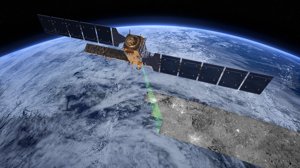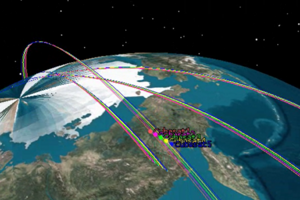‘The Netherlands is leading in small satellites; that is why we need to invest’
With the Partnerships for Space Instruments & Applications Preparatory Programme, the Netherlands is supporting technological breakthroughs and scientific cooperation in space research. The 'Dutch Network on Small Spaceborne Radar Instruments and Applications' is working on smaller radar instruments that can fly through space like a swarm.
Sentinel-1 is an example of a large and complex radar satellite. | Source: Sentinel-1
Radar instruments are advancing in space. They are used for weather forecasting and climate research, but also for monitoring infrastructure, subsidence, illegal construction, and shipping. The advantage of radar instruments is that they are always able to make observations, even when it is dark or raining. There is also a disadvantage: the instruments are large and complex. According to coordinator Paco Lopez Dekker, this is a great opportunity for the Expertise Network Radar Technology and for the Netherlands.
Dekker is associate professor of remote sensing at Delft University of Technology. He wants to make radar technology so small that it can fly on the smallest satellites, cubesats. But that is only possible if various parties in the Netherlands join forces: 'An instrument cannot be seen as disconnected from the satellite it is on. And the satellite only exists by the needs of the users. The Expertise Network unites the entire chain: from user and instrument developer to the people who integrate the instruments on the satellites. That's where the added value lies.’

Example of a constellation of miniaturized radar altimeters. | Source: NL-RIA / dr. Yuanhao Li
The Expertise Network Radar Technology has grown into a large group of knowledge institutions and companies that approaches the topic from various perspectives. In addition to TU Delft, these include TNO, NLR, Airbus Defence and Space Netherlands and ISIS. Companies working on applications of radar data from space, such as Swartvast, Metasensing, Deltares, FutureWater and VanderSat are also participating. The focus is on the development of miniaturized radar altimeters and smart deployable radar antennas.
'Ordinary cameras are easy to miniaturize,' Lopez Dekker explains. 'That's much harder with radar instruments. We have developed a concept for a radar altimeter that fits on cubesats. ESA is interested in this technology, so we are currently building a working prototype with SME RFx solutions.' If this is successful, it will become easier to do more altitude measurements with many different, small satellites. This will lead to the need for, and the second major line of research in our Expertise Network: distributed systems.
Future radar observations are likely to be made with a cloud of small satellites - a swarm - that communicate with each other. The swarm is able to control itself, split itself up, and even "repair" itself, should the need arise. And the swarm can make advanced observations that are not possible with a single satellite, such as direct motion detection. 'We are one of the groups in the world working on the technology to make this possible. If we manage to get constellations to fly the way we want, that's really a game changer for radar measurements.'

Artist impression of a cloud of small satellites communicating with each other. | Source: NL-RIA
Another important topic for the Expertise Network is the continued development of antennas. 'The antenna is the most visible and most problematic component,' says Lopez Dekker. 'If you want to generate a good signal, it actually has to be very large. We want to make smaller instruments. That's why one of the researchers in the network is working on deployable antennas. These are interesting for radar instruments, but also for communication systems. In fact, for all systems that use radio and microwaves.'
The added value of his Expertise Network has been demonstrated in recent years, Lopez Dekker believes. That is precisely why he thinks the collaboration should continue. He dreams of a future in which the concepts currently being developed actually fly in space, as a national project. We have invested in small satellites because the Netherlands is a leader in this field. We have SMEs that are capable of building anything we propose. And the costs of such a project, unlike the development of a large satellite, are easy for the Netherlands to bear.'
Still, there is a lot to be done before Dutch radar instruments will detect land subsidence, support shipping, or help in agriculture and forestry. 'We are running into the same problem as the other groups working on this: to arrive at a tangible, working prototype, a lot of money is needed. We need to keep the collaboration alive even after the Expertise Networks project and start seeking funding. That's the challenge we face as a network.'
Dutch Network on Small Spaceborne Radar Instruments and Applications (NL-RIA): https://nl-ria.nl/